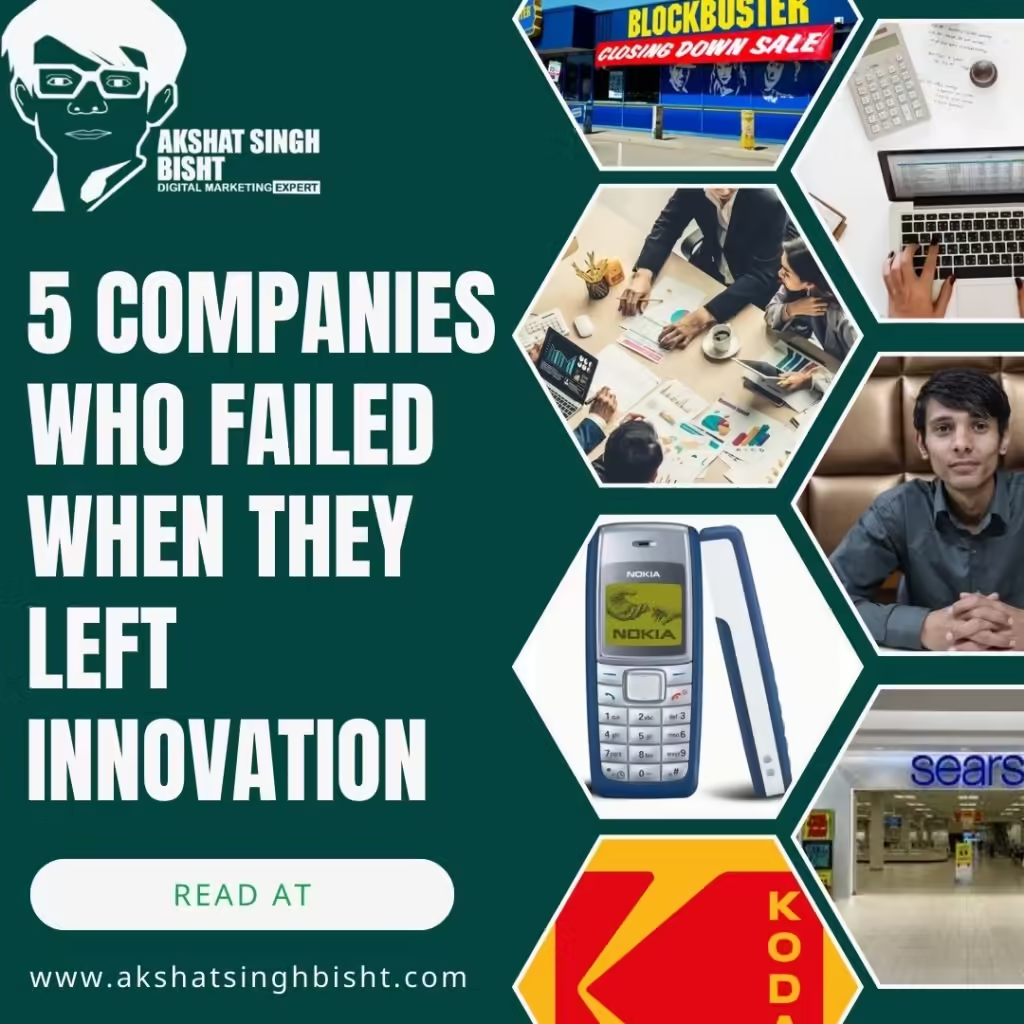Innovation has long been the cornerstone of successful businesses. It’s the driving force that propels companies forward, enables them to adapt to changing markets, and helps them stay ahead of competitors. However, history is replete with examples of companies that, once leaders in their industries, faltered when they neglected innovation. This blog will explore several case studies of companies that failed because they stopped innovating, highlighting the importance of continual growth and adaptation in business.

Blockbuster was once the behemoth of the video rental industry. At its peak in the early 2000s, the company had over 9,000 stores worldwide and was the go-to place for renting movies and video games. Blockbuster’s initial success was due to its innovative business model, which provided a wide selection of movies and games, coupled with convenient rental terms.
The advent of digital technology and the rise of online streaming services marked the beginning of Blockbuster’s downfall. Netflix, which started as a DVD rental service by mail, embraced the potential of streaming technology. Blockbuster, on the other hand, failed to recognize the importance of this innovation. Despite having the opportunity to purchase Netflix for $50 million in 2000, Blockbuster’s leadership declined the offer, viewing it as a niche service with limited potential.
Blockbuster’s inability to innovate and adapt to the changing landscape of digital entertainment led to its bankruptcy in 2010. Today, only a single Blockbuster store remains, serving as a nostalgic reminder of the company’s once-dominant presence.
Kodak was a pioneer in the photography industry, renowned for its innovative cameras, film, and photographic supplies. For much of the 20th century, Kodak was synonymous with photography, capturing memories for millions around the world.
Despite being a leader in film photography, Kodak failed to embrace the digital revolution. Ironically, Kodak engineers invented the first digital camera in 1975, but the company’s leadership chose to suppress this innovation, fearing it would cannibalize their lucrative film business. As digital photography gained popularity, companies like Canon and Sony swiftly adapted to the new technology, leaving Kodak behind.
Kodak’s refusal to innovate and pivot towards digital photography resulted in a significant loss of market share. By 2012, the company filed for bankruptcy, having failed to keep pace with the rapidly changing technology landscape.
Nokia was once the undisputed leader in the mobile phone industry. In the late 1990s and early 2000s, the Finnish company dominated the global market, known for its reliable and user-friendly phones.
Nokia’s decline began with the rise of smartphones. The company underestimated the potential of smartphones and continued to focus on traditional mobile phones. Meanwhile, Apple and Google revolutionized the market with the iPhone and Android operating system, respectively. Nokia’s attempt to catch up with its own Symbian and later Windows Phone operating systems came too late.
By 2014, Nokia’s mobile phone business was sold to Microsoft, marking the end of an era. Nokia’s failure to innovate and adapt to the smartphone revolution was a critical factor in its downfall.
Sears was once the largest retailer in the United States, a household name synonymous with quality products and a vast selection of goods. Founded in the late 19th century, Sears revolutionized the retail industry with its mail-order catalog and later, its department stores.
As e-commerce began to reshape the retail landscape, Sears failed to adapt. The company was slow to develop a robust online presence and struggled to compete with emerging giants like Amazon. Instead of investing in technology and innovation, Sears focused on cost-cutting measures and short-term financial gains.
Sears’ lack of innovation and inability to compete in the digital age led to a steady decline in sales and market share. By 2018, the company filed for bankruptcy, marking the end of an iconic American retailer.
BlackBerry was an early innovator in mobile communication, known for its secure email and messaging services. In the mid-2000s, BlackBerry devices were ubiquitous in the business world, favored for their robust security features and physical keyboards.
The introduction of the iPhone in 2007 marked a significant shift in consumer preferences towards touchscreen smartphones. BlackBerry was slow to adapt, clinging to its physical keyboard and enterprise-focused strategy. The company’s attempts to introduce touchscreen devices were too little, too late, as consumers flocked to more innovative and user-friendly alternatives.
By the mid-2010s, BlackBerry had lost its dominant position in the mobile phone market. The company eventually exited the hardware business, focusing instead on software and security services.
The failure of these companies underscores the importance of continuous innovation. Markets and technologies are constantly evolving, and companies must be willing to adapt and innovate to stay relevant.
Disruption is inevitable in any industry. Companies that embrace disruptive technologies and business models are better positioned to succeed. Conversely, those that resist change risk becoming obsolete.
Understanding and anticipating customer needs is vital. Companies that failed to innovate often lost touch with their customers’ evolving preferences and behaviors.
A forward-looking strategic vision is essential. Companies need leaders who can foresee industry trends and steer the organization towards future growth opportunities.
Innovation often involves taking risks. Companies that are too risk-averse may miss out on significant opportunities for growth and transformation.
The stories of Blockbuster, Kodak, Nokia, Sears, and BlackBerry serve as cautionary tales for businesses across all industries. Innovation is not a one-time event but a continuous process that requires a commitment to staying ahead of the curve. In a rapidly changing world, companies that neglect innovation do so at their peril, risking irrelevance and failure. To thrive in the long term, businesses must foster a culture of innovation, embrace change, and continually adapt to meet the demands of an ever-evolving marketplace.
Akshat’s passion for marketing and dedication to helping others has been the driving force behind AkshatSinghBisht.com. Known for his insightful perspectives, practical advice, and unwavering commitment to his audience, Akshat is a trusted voice in the marketing community.
If you have any questions simply use the following contact details.